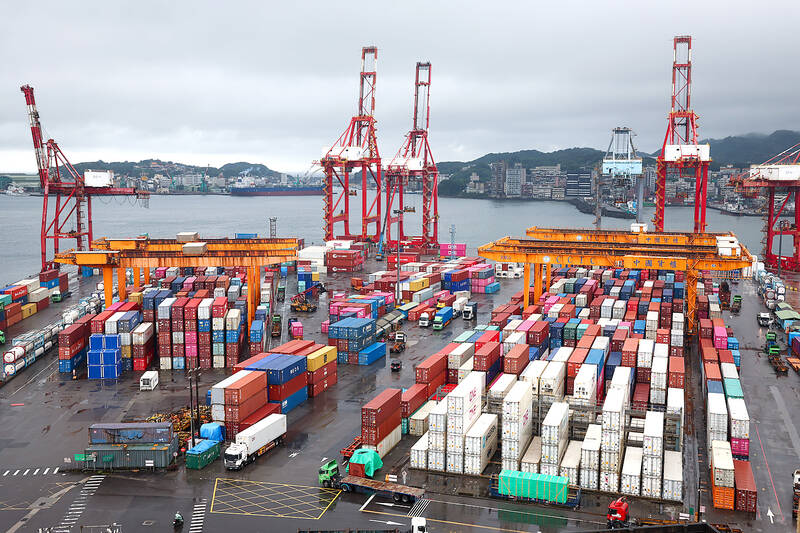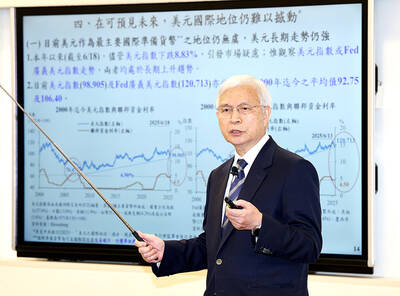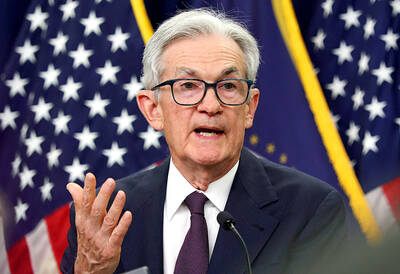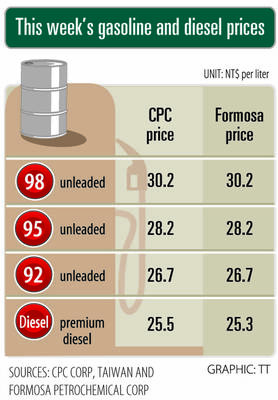Exports last month spiked 18.6 percent from a year earlier to a new high of US$49.57 billion, driven by front-loading demand on the part of corporations to cope with US President Donald Trump’s threat of “reciprocal” tariffs, the Ministry of Finance said yesterday.
Last month’s results turned out way better than expected, approaching the US$50 billion mark for the first time despite the weak seasonality, but it remains to be seen if the momentum is sustainable this month and beyond, Department of Statistics Director-General Beatrice Tsai (蔡美娜) said.
Tsai said she is looking at a flat showing for this month, when exports are likely to hold steady or grow 5 percent from the year-ago figures.

Photo: CNA
“The speculation doesn’t factor in US tariff hikes, because it is hard to predict Trump’s next moves and it is too early to gauge repercussions from Washington’s drastic tariffs on China,” Tsai said.
China, including Hong Kong, remains Taiwan’s largest export destination with a 28.9 percent share, though the US is catching up with a 25.7 percent share, propelled by the artificial intelligence (AI) craze, the ministry’s latest data showed.
Furthermore, it is not clear how Taiwanese firms would tackle the major shift in US trade policy, Tsai said.
Some would wait and see, while others are adjusting their global footprint, the official said.
Still others might be pushed out of the market altogether due to a lack of competitiveness, she added.
Regardless, Taiwan’s exports in the first quarter swelled 17.5 percent year-on-year to US$129.58 billion, beating the forecast of the Directorate-General of Budget, Accounting and Statistics (DGBAS) by 7.3 percentage points, Tsai said.
That is favorable for GDP growth, but economic policymakers and academics have voiced grave concern that Taiwan’s export-focused economy would start to feel the pain of tariffs in the second half.
Shipments of semiconductors expanded 20.6 percent to US$16.46 billion, while information and communications technology products grew 34 percent to US$16.94 billion, Tsai said, adding that the fast growth also had much to do with AI development.
Front-loading activity extended to non-tech products, as seen in double-digit increases in shipments of electrical, optical and mineral products, the ministry said.
Textile and plastic products bucked the upward trend with declines of 6.8 percent and 4.6 percent respectively, as a supply glut and rising competition from Chinese rivals continued to weigh, Tsai said.
At the same time, imports rose 28.8 percent annually to US$42.6 billion, leaving a trade surplus of US$6.95 billion, a 20.1 percent retreat from a year earlier, the official said.
In the first three months, imports amounted to US$106.02 billion, also stronger than the DGBAS’ projection.
Taiwan’s policymakers have suggested the country buy more military weapons, energy and agricultural products from the US to mitigate trade surpluses with the US and appease Trump.

NOT JUSTIFIED: The bank’s governor said there would only be a rate cut if inflation falls below 1.5% and economic conditions deteriorate, which have not been detected The central bank yesterday kept its key interest rates unchanged for a fifth consecutive quarter, aligning with market expectations, while slightly lowering its inflation outlook amid signs of cooling price pressures. The move came after the US Federal Reserve held rates steady overnight, despite pressure from US President Donald Trump to cut borrowing costs. Central bank board members unanimously voted to maintain the discount rate at 2 percent, the secured loan rate at 2.375 percent and the overnight lending rate at 4.25 percent. “We consider the policy decision appropriate, although it suggests tightening leaning after factoring in slackening inflation and stable GDP growth,”

DIVIDED VIEWS: Although the Fed agreed on holding rates steady, some officials see no rate cuts for this year, while 10 policymakers foresee two or more cuts There are a lot of unknowns about the outlook for the economy and interest rates, but US Federal Reserve Chair Jerome Powell signaled at least one thing seems certain: Higher prices are coming. Fed policymakers voted unanimously to hold interest rates steady at a range of 4.25 percent to 4.50 percent for a fourth straight meeting on Wednesday, as they await clarity on whether tariffs would leave a one-time or more lasting mark on inflation. Powell said it is still unclear how much of the bill would fall on the shoulders of consumers, but he expects to learn more about tariffs

Greek tourism student Katerina quit within a month of starting work at a five-star hotel in Halkidiki, one of the country’s top destinations, because she said conditions were so dire. Beyond the bad pay, the 22-year-old said that her working and living conditions were “miserable and unacceptable.” Millions holiday in Greece every year, but its vital tourism industry is finding it harder and harder to recruit Greeks to look after them. “I was asked to work in any department of the hotel where there was a need, from service to cleaning,” said Katerina, a tourism and marketing student, who would

i Gasoline and diesel prices at fuel stations are this week to rise NT$0.1 per liter, as tensions in the Middle East pushed crude oil prices higher last week, CPC Corp, Taiwan (台灣中油) and Formosa Petrochemical Corp (台塑石化) said yesterday. International crude oil prices last week rose for the third consecutive week due to an escalating conflict between Israel and Iran, as the market is concerned that the situation in the Middle East might affect crude oil supply, CPC and Formosa said in separate statements. Front-month Brent crude oil futures — the international oil benchmark — rose 3.75 percent to settle at US$77.01